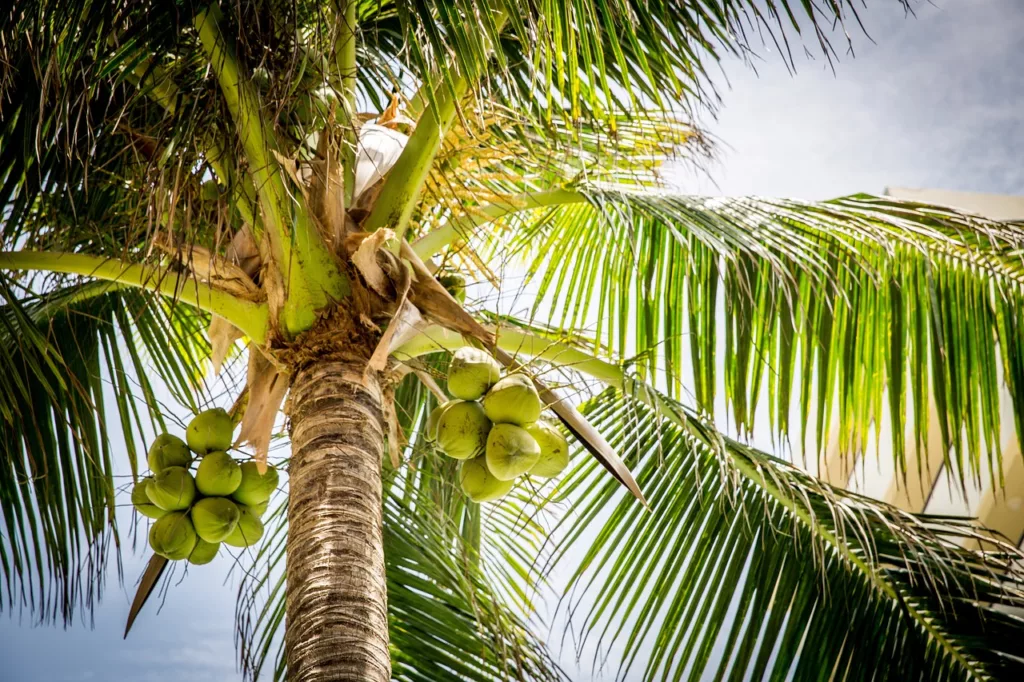Coconut milk, a versatile and cherished ingredient, hails from tropical coconut-bearing palms. Its creamy elixir enhances global kitchens, adding a rich, exotic dimension to numerous recipes. In this article, we’ll delve into Coconut Milk vs. Coconut Cream. There origins, nutritional perks, culinary applications, and even homemade preparation.
Coconut Milk vs. Coconut Cream
Understanding the Difference
People commonly use coconut milk and coconut cream interchangeably, yet these two have distinct characteristics:
- Coconut Milk: As mentioned earlier, it’s created by blending grated coconut flesh with water, resulting in a thinner consistency and lower fat content.
- Coconut Cream: Crafted from the same process as coconut milk but with less water, this version is thicker and richer. Ideal for desserts and cocktails, it imparts a luxurious, velvety texture.
Coconut Milk Vs. Coconut Cream Quick Comparision Chart
This table provides a clear overview of the distinctions between coconut milk and coconut cream, helping you choose the right ingredient for your culinary needs.
| Aspect | Coconut Milk | Coconut Cream |
|---|---|---|
| Consistency | Thinner and lighter | Thicker and richer |
| Fat Content | Lower fat content | Higher fat content |
| Texture | Light and liquid | Creamy and velvety |
| Ideal Uses | Soups, curries, beverages, desserts | Desserts, cocktails, rich sauces |
| Cooking Applications | Versatile in both sweet and savory dishes | Primarily used in sweet dishes |
| Health Considerations | Lighter option for those seeking lower fat content | Higher fat content for indulgent dishes |
| Consistency in Recipes | Can be used to thin down recipes | Adds richness and creaminess to recipes |
| Storage | Usually available in cartons or cans | Commonly found in cans or tubs |
| Caloric Content (per serving) | Generally lower in calories | Higher caloric content per serving |
| Culinary Examples | Used in Thai and Indian curries, smoothies, and soups | Perfect for coconut-based desserts like coconut cream pie, ice cream, and panna cotta |
| Texture in Coffee | Lighter and may not provide a rich, creamy texture | Adds a luxurious creaminess to coffee |
| Nutritional Characteristics | Contains fewer calories and less fat | Offers a higher concentration of fats and calories |
| Chill Compatibility | Tends to separate when chilled and may require shaking | Remains thick and creamy when chilled |
The Coconut’s Secret: How is Coconut Milk Made?
Extracting the Liquid Gold
Contrary to expectations, coconut milk isn’t the liquid inside a fresh coconut. It’s made by blending grated coconut flesh with water and then straining the mixture. The result is a thick, creamy liquid with a distinct tropical aroma and flavor.
Types of Coconut Milk
- First Pressed – Known as “thick” or “full-fat” coconut milk, this type is made from the first pressing of coconut flesh. It’s rich and dense, perfect for curries and desserts.
- Second Pressed – This is lighter and thinner than the first-pressed version, often used for soups and beverages.
- Canned vs. Fresh – While canned coconut milk is readily available, many opt for the fresh variety, which involves grating and extracting coconut in your kitchen.

Nutritional Bounty: What’s Inside Coconut Milk?
A Healthy Alternative
Coconut milk stands as a nutritional powerhouse, housing essential vitamins, minerals, and healthy fats. It’s a favored option for those in search of a dairy-free, lactose-free alternative. Let’s delve into key nutrients found in coconut milk:
- Medium-Chain Triglycerides (MCTs): These fats are easily digestible and provide a quick source of energy.
- Vitamins: Coconut milk is a source of vitamins C, E, and various B vitamins.
- Minerals: It’s rich in minerals like magnesium, potassium, and iron.
Culinary Wonders: Cooking with Coconut Milk
Versatility in the Kitchen
Coconut milk’s versatility knows no bounds. It seamlessly integrates into both sweet and savory dishes. Here are some popular culinary applications:
- Curries: Coconut milk is a staple in Thai and Indian curries, lending a creamy texture and mellowing the spice.
- Desserts: It’s a star ingredient in tropical desserts like coconut rice pudding and coconut flan.
- Beverages: From piña coladas to smoothies, coconut milk adds a delightful creaminess.
DIY Coconut Milk: How to Make It at Home
The Homemade Goodness
If you’re looking for a hands-on culinary adventure, making coconut milk at home is both rewarding and delicious. Here’s a simplified recipe:
- Ingredients:
- Freshly grated coconut
- Water
- Steps: a. Blend the grated coconut with warm water. b. Strain the mixture through a cheesecloth or nut milk bag. c. Squeeze out every drop of creamy goodness.
The Trees That Bear the Treasure
Coconut Palm Trees
Coconut milk and cream originate from the fruit of the coconut palm tree (Cocos nucifera). These tall, slender trees are a common sight in tropical regions, where they thrive in sandy soils and warm, humid climates.

Harvesting coconuts involves:
- Climbing the Tree: Skilled harvesters climb the trees using ropes and hooks or with the help of specially trained monkeys in some regions.
- Harvesting the Coconuts: Once at the top, they carefully collect the coconuts by hand or using long sticks.
- Cracking and Extracting: Back on the ground, the coconuts are cracked open to reveal the white flesh and the liquid, which is later used to make coconut milk.
FAQ:
Yes, coconut milk is a popular dairy-free option for vegans and lactose-intolerant individuals.
Absolutely! Many people enjoy the creamy texture and mild coconut flavor it adds to their morning coffee.
No, they are not the same. Coconut water is the clear liquid found inside a young green coconut, while coconut milk is made from the flesh of mature coconuts.
In general, coconut milk is safe for consumption. However, like any food, it should be enjoyed in moderation as part of a balanced diet.
Yes, you can freeze coconut milk. Be sure to use an airtight container, as it can expand when frozen.
Conclusion: Coconut Milk vs. Coconut Cream
In conclusion, coconut milk goes beyond being a kitchen staple; it’s a culinary treasure. Its rich flavor, versatility, and health benefits make it a favorite among food enthusiasts globally. Knowing the difference between coconut milk and coconut cream, and appreciating the remarkable coconut palm trees that yield this treasure, enhances our understanding and admiration for this versatile ingredient.




